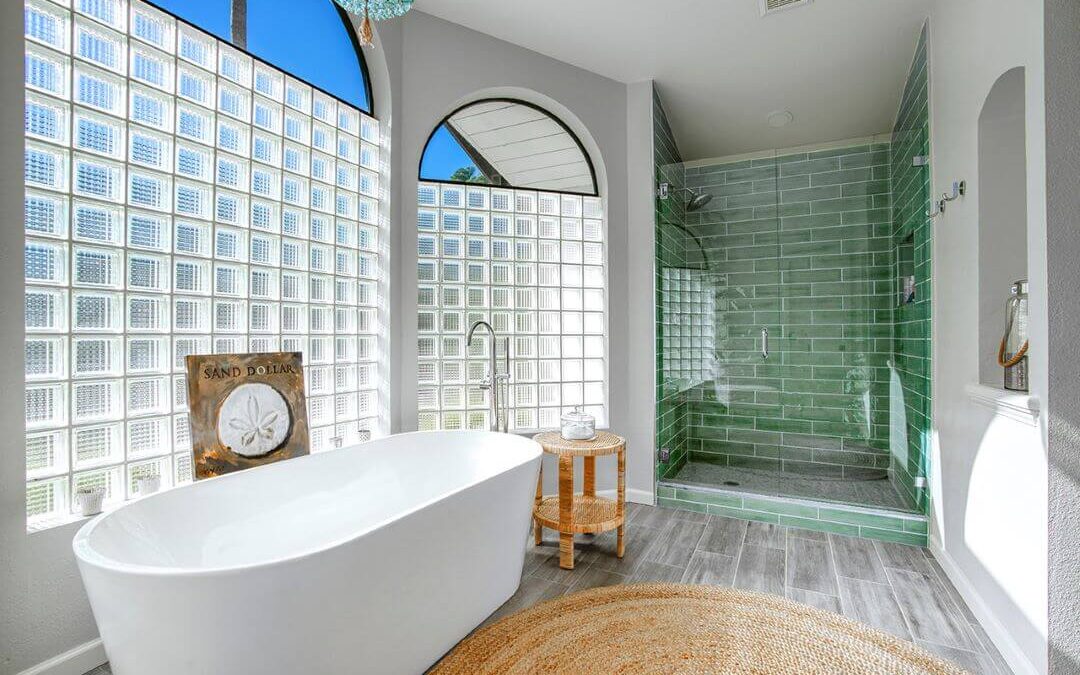While a bathtub serves an important function, it can also be so much more than a place to get washed up. When designing your bathroom, you can use it to elevate the space into a calming retreat away from the stress of everyday life. The question is, should you go with a freestanding tub or a built-in tub? Both can bring great qualities to a bathroom; it just depends on what you want it to be.
What’s the Difference?
When it comes to the differences between a freestanding tub and a built-in tub, it’s all in the name. A freestanding tub stands on its own, unattached to the walls and often raised up on legs or a pedestal. The Victorian Era clawfoot tub featured in many period films is a good example.
A built-in tub is something you’re probably more familiar with in your own experience, usually set into an alcove with walls on three sides and typically a shower head as well. If you think back to your first apartment, chances are you had a built-in tub. Both kinds of tubs come with a variety of sizes, finishes, and features that can make them appealing to the prospective bather. Here are a few of their specific standout qualities.
Freestanding Tub
Freedom of Placement
A freestanding tub affords you a lot more license when deciding where to place it in your bathroom. Since it doesn’t need to be affixed to the wall, anywhere with adjacent plumbing will do the trick. This can be quite appealing to homeowners looking to take creative liberties with a remodel. If you want to place the bathtub up against a window, near the wall, or even the center of the room, as long as the plumbing cooperates, you can do it.
Stylish and Modern Design
A freestanding tub is also a dramatic stylistic choice, opening up the space in a way that brings a lot of air and light to your bathroom. In addition, freestanding tubs tend to have a wider variety of aesthetic choices than their built-in counterparts. Since the freestanding tub features more prominently than a built-in, it can function almost like a piece of furniture from a design perspective. Whether you want something cozy and warm or sleek and minimalist, chances are you can find the freestanding tub to serve as the focal point to bring it all together.
No Room for Toiletries
One thing to keep in mind with a freestanding tub is that while their careful placement can be bold and evocative, they can also leave you floating adrift in your own bathroom. Many built-in tubs have small nooks or racks for you to place your soap, shampoo, and towels, but the average freestanding tub does not. Instead of thinking of this as a downside, try thinking of it as another design challenge. Work with your contractor to come up with a solution that leaves all your sundries within arm’s reach. With some creative placement of towel stands and accent tables, you can be sure you’ll have everything you need.
Built-in Tub
Great for Showers As Well As Baths
If you expect to shower more often than you take baths, a built-in may be your best bet. With three moisture-resistant walls enclosing most of the space, it’s much easier to keep the water contained and off your floors. To install a shower in a freestanding tub, you need to choose a model that will accommodate not only a shower head but a ring to hang your shower curtain from. Some people choose to have their cake and eat it too, installing a separate shower stall in their bathroom along with a freestanding. If that’s not a feasible option though, a built-in will do a better job at pulling double duty.
A Little More Cost Effective
In general, a built-in tub will tend to be a bit cheaper than a freestanding one. Since a built-in tub only needs to have one finished side, while a freestanding one needs to look presentable from all angles, the up-front cost of a built-in is lower on average. Of course, if your installation will require any major work on your plumbing or the area surrounding your tub, that difference might be negligible.
Installation Can Be More Difficult
Installing a freestanding tub can be quite easy once you have it in the room. All you need to do is find where you want it to be, connect it to the plumbing, and call it a day. A built-in tub, however, requires a bit more handiwork. Since a built-in tub needs to be set directly into the wall, it’s not as simple as just connecting the pipes. You’ll need to have it mounted, sealed, and the surrounding area finished with water-resistant materials such as acrylic paneling or tile. Add in a glass shower door, and you have more time and money spent. That being said, if a built-in is the right choice for your bathroom, then you shouldn’t let the prospect of installation hold you back.
What to Choose?
Ultimately, two things will determine what is the right tub for you: your design vision and the bathroom you’re working in. Before you start renovating, picture what your perfect bathroom looks like. How do you want it to make you feel? What colors, designs, and motifs appeal to you? What would fit in with the rest of your home, adding to one cohesive aesthetic?
Take that ideal bathroom and apply it to the space you have. Figure out what makes sense with the plumbing, the square footage, and your budget. And don’t worry, we’ll be with you every step of the way. From the initial design phase to picking out just the right materials to executing the plan, the team at JMG Contracting is here to lend our help and expertise to your remodel. With a little help, you’ll be soaking in the right tub for you in no time.



